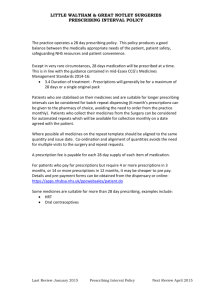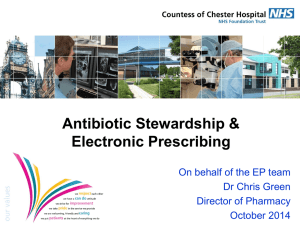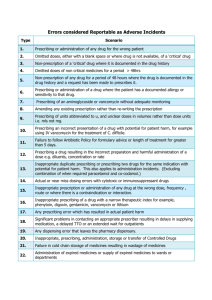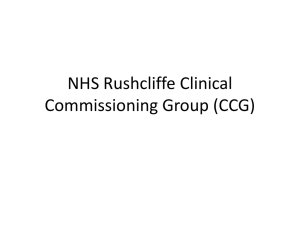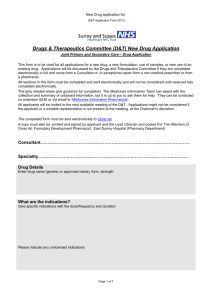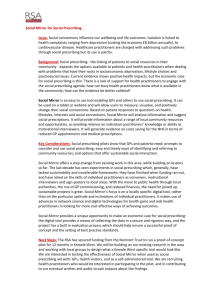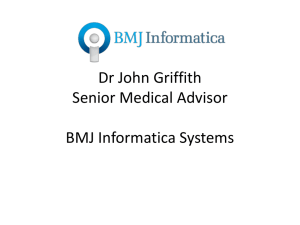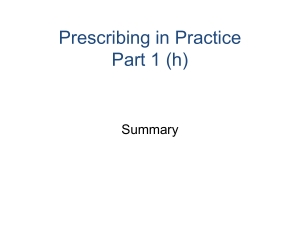Prescribing Errors in GP
advertisement
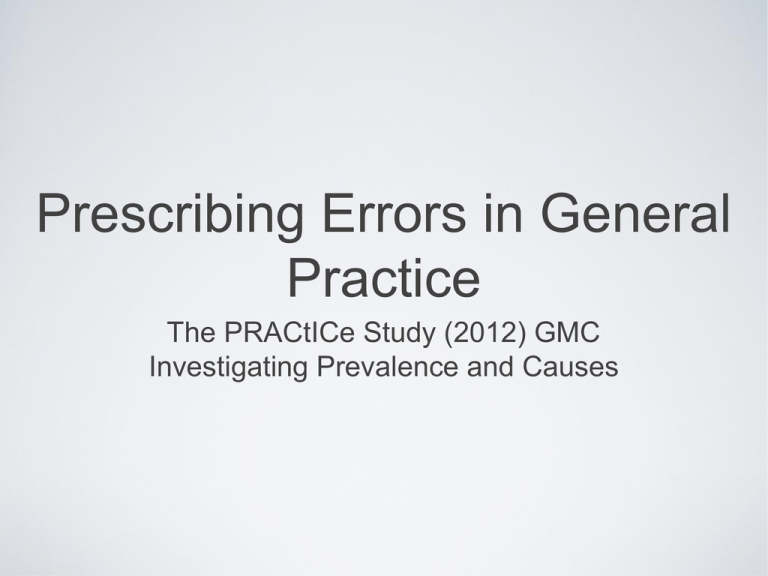
Prescribing Errors in General Practice The PRACtICe Study (2012) GMC Investigating Prevalence and Causes Definition • “A prescribing error occurs when, as a result of a prescribing decision or the prescription-writing process, there is an unintentional, significant reduction in the probability of treatment being timely or effective, or increase in the risk of harm when compared to generally accepted practice” Methods • Systematic Review • Retrospective review of (2%) sample of prescriptions from 15 practices over 12 months • Interviews with prescribers for 70 potential errors • 15 root cause analyses • 6 focus groups Results • >6000 items for nearly 1800 patients • prescribing / monitoring errors detected for 1 in 8 patients or 1 in 20 prescriptions • 1 in 550 items severe error Factors associated with an increased risk of error • male patient • aged <15 or >64 • increased number of items prescribed • musculoskeletal, immunosupression & malignancy, skin, eye, ENT, cardiovascular disease, infections • smaller practices Factors not associated with an increased risk of error • grade of GP • acute or repeat prescription Commonest Errors • incomplete information on the prescription (30%) • dose/strength errors (17.8%) • incorrect timing of doses (10.5%) • failure to request monitoring (69.1%) Medicines Reconciliation • 97% of hospital discharge prescriptions contained an alteration from admission drugs • 10% of these involved a change in dose (none highlighted) • 34% of discharge medications were ‘new’ (only 8% highlighted) • discrepancies occurred in 42% of subsequent GP prescriptions Causes of Error • The Prescriber • The Patient • The Team • The Working Environment • The Task • The Computer System • The Primary Secondary Care Interface Causes - the Prescriber • therapeutic training, drug knowledge and experience • knowledge of the patient • perception of risk • physical and emotional health Causes - Patient & Team • patient characteristics • complexity of individual case • poor communication • nurses’ quasi-autonomous role Causes - Environment & Task • high workload • time pressures • distractions and interruptions • failure to undertake review • monitoring reminder systems Causes - Computing & Interface • selecting wrong drug or dosage on pick lists • overriding interaction alerts • unnecessary/inappropriate alerts • failure to maintain accurate electronic records • poor quality correspondence Defences • issuing new prescriptions • supporting patient decision making • dispensing prescriptions • monitoring patients • amending prescriptions from outside correspondence • processes supporting medicines management Personal Prescriber Strategies • read aloud printed prescriptions to help check patient understanding and allow prescriber to check accuracy • clarifying specialist recommendations where these go beyond GP’s comfort zone • review newly prescribed medications within 6 weeks • add repeat medications only when patient stable • confirm important information with patient even when well known to prescriber • ensuring prescribers are competent to use all important features of e-prescribing and IT support systems Key Practice-Wide Strategies • adopt a formulary to increase familiarity with medicines prescribed • discourage verbal requests for repeat prescriptions • invest in non-medical staff training / dedicated team for repeat prescriptions • schedule blood tests 1 week before reviews / perform face to face medication reviews • do not delegate responsibility for difficult patients to locums or junior GPs • update prescribing record within 48 hours of receiving correspondence • appoint a practice prescribing lead, build a strong safety based culture, based on blame-free communication Key Health Technology Strategies • code allergies in electronic records • robust alerts for high risk medicines • provide online access to medicines information, linking directly from clinical computer system • embed electronic formulary, use it to guide safer choices • separate drugs with similar names in pick lists • grade drug interaction alerts and give brief descriptions of interaction problems • run searches/audits to identify potential errors & patients requiring monitoring (particularly warfarin), use screen alerts to highlight these • locum induction package to include familiarisation with information technologies available Recommendations for GP Training • greater prominence for therapeutics in curriculum • educational packages to support prescribing safety and structured medication reviews • facility in ePortfolio to record educational activities relating to prescribing • prescribing competence to be part of MRCGP • support for transition to independent practice Recommendations for CPD • educational package to support reflection on and support for identified learning needs from PRACtICe study • strategies to support GPs dealing with high risk prescribing scenarios • strategies to help GPs make best use of prescribing IT • strategies to improve prescribing safety systems Recommendations for Clinical Governance • conduct audits using prescribing safety indicators and correct problems identified using evidence based approaches • conduct significant event analyses • report prescribing adverse events (and near misses) using National Reporting and Learning System
